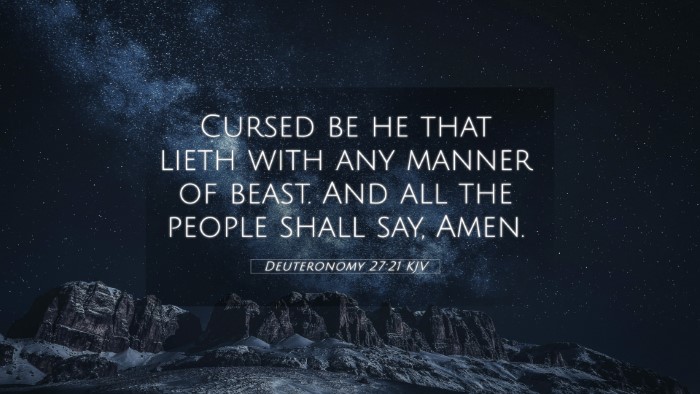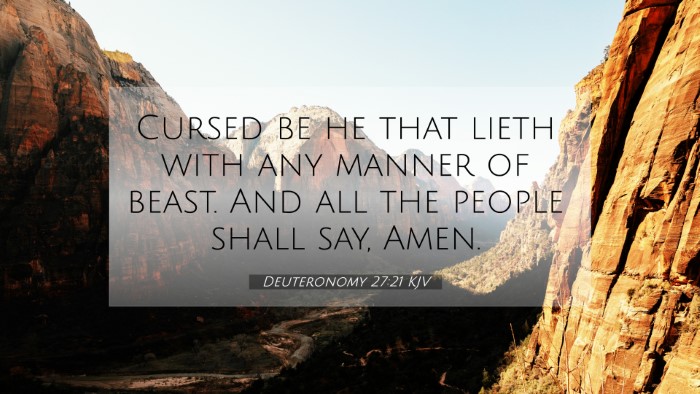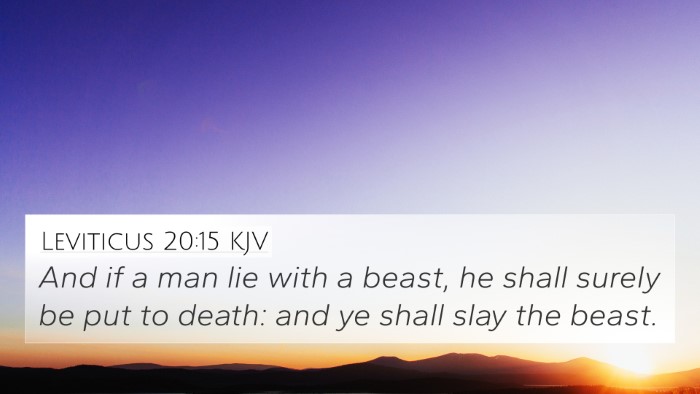Understanding Deuteronomy 27:21
Verse: Deuteronomy 27:21 - "Cursed be he that lieth with any manner of beast. And all the people shall say, Amen."
Meaning and Interpretation
Deuteronomy 27:21 presents a significant warning against bestiality, a sin that was abhorred in ancient Israel. This law underscores the seriousness with which God views sexual immorality and its repercussions on the moral fabric of society. The verse encapsulates both a curse for the transgressor and a communal affirmation by the people affirming the law’s validity.
Insights from Public Domain Commentaries
- Matthew Henry: He emphasizes the gravity of bestiality, pointing out that it represents a gross violation of natural order and divine law. Henry remarks that the public acknowledgment of this curse serves to strengthen communal ethics and societal structures. He notes that the people's response ("Amen") is a critical aspect, signifying their agreement with God's judgment.
- Albert Barnes: Barnes elaborates on the intent behind the cursing, suggesting it serves not only as a condemnation of the act but also as a deterrent against immorality. He highlights that this law reflects a broader principle regarding the sanctity of life and relationships ordained by God, reinforcing the importance of adhering to divine statutes to maintain societal purity.
- Adam Clarke: Clarke provides historical context, indicating that bestiality was prevalent in various pagan cultures surrounding Israel. He asserts that the Lord's command against such practices cleaved the Israelites to a higher moral standard, differentiating them from surrounding nations. Clarke also notes the role of public participation in affirming God's laws, insisting that such declarations bolster communal integrity.
Cross-Referencing Related Scriptures
To fully comprehend Deuteronomy 27:21, one can explore its connections with other scripture passages. Below are key verses that reinforce or relate to this commandment:
- Leviticus 18:23: "Neither shalt thou lie with any beast to defile thyself therewith." This command directly complements the warning found in Deuteronomy.
- Exodus 22:19: "Whosoever lieth with a beast shall surely be put to death." This verse outlines the moral and legal consequences of such acts.
- Romans 1:24-27: Paul’s discussion on immoral behaviors, including unnatural relations, echoes the seriousness of these transgressions.
- 1 Corinthians 6:9-10: Lists various sinners, reiterating that those who engage in immorality will not inherit the kingdom of God.
- Genesis 19:5: The account of Sodom and Gomorrah highlights the extreme cases of sexual immorality condemned by God.
- 2 Peter 2:10: Mentioning those who despise authority and indulge in fleshly desires offers a cautionary note against such immoral behaviors.
- Hebrews 13:4: "Marriage is honorable in all, and the bed undefiled: but whoremongers and adulterers God will judge." This aligns moral purity with divine judgement.
Connecting Bible Verses
The analysis of Deuteronomy 27:21 illuminates several key themes in Scripture related to morality, law, and community responsibility. Through cross-referencing, we can identify a web of Biblical truths that echo this verse:
- Moral Purity: The consistent demand for moral integrity is found throughout the Bible, from the Old Testament laws to New Testament teachings.
- Community Accountability: The concept of communal affirmations of God's laws, as seen when the people respond "Amen," shows that churches and communities play a vital role in upholding morality.
- Consequences of Sin: There is a recurring theme that actions against God’s laws lead to severe consequences, affirming that God's justice upholds His righteousness.
Tools and Methods for Cross-Referencing
To deepen your understanding and facilitate study, it is beneficial to utilize tools for Bible cross-referencing. Some effective methods include:
- Bible Concordance: A concordance helps locate verses based on keywords, showing their contexts and connections.
- Bible Cross-Reference Guide: Such guides provide side-by-side comparisons of related verses to highlight thematic connections.
- Cross-Reference Bible Study: Engage in studies that focus on a specific theme or verse, exploring related scriptures that enrich understanding.
- Comprehensive Bible Cross-Reference Materials: Invest in study Bibles that include extensive cross-references to gain insights into the text.
Conclusion
Deuteronomy 27:21 stands as a stark reminder of the Holy Scriptures' stance on sexual immorality. The interpretation of this verse, in conjunction with other Biblical texts, reveals a cohesive narrative about God’s standards for human behavior. By employing the tools of cross-referencing and examining inter-Biblical dialogues, one can uncover rich, thematic connections that continue to guide moral and ethical decisions today.





